Related Research Articles
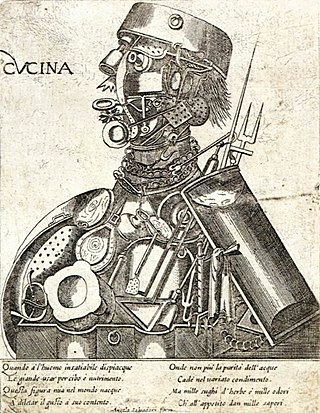
Cyberspace is a concept describing a widespread interconnected digital technology. "[The expression dates] from the first decade of the diffusion of the internet. It refers to the online world as a world 'apart,' as distinct from everyday reality. In cyberspace people can hide behind fake identities, as in the famous The New Yorker cartoon ..." The term entered popular culture from science fiction and the arts but is now used by technology strategists, security professionals, governments, military and industry leaders and entrepreneurs to describe the domain of the global technology environment, commonly defined as standing for the global network of interdependent information technology infrastructures, telecommunications networks and computer processing systems. Others consider cyberspace to be just a notional environment in which communication over computer networks occurs. The word became popular in the 1990s when the use of the Internet, networking, and digital communication were all growing dramatically; the term cyberspace was able to represent the many new ideas and phenomena that were emerging.
net.art refers to a group of artists who have worked in the medium of Internet art since 1994. Some of the early adopters and main members of this movement include Vuk Ćosić, Jodi.org, Alexei Shulgin, Olia Lialina, Heath Bunting, Daniel García Andújar, and Rachel Baker. Although this group was formed as a parody of avant garde movements by writers such as Tilman Baumgärtel, Josephine Bosma, Hans Dieter Huber and Pit Schultz, their individual works have little in common.
24 Hours in Cyberspace was "the largest one-day online event" up to that date, headed by photographer Rick Smolan with Jennifer Erwitt, Tom Melcher, Samir Arora and Clement Mok. The project brought together the world's top 1,000 photographers, editors, programmers, and interactive designers to create a digital time capsule of online life."
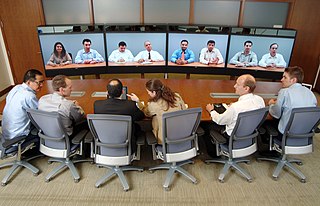
Videotelephony is the two-way or multipoint reception and transmission of audio and video signals by people in different locations for real-time communication. A videophone is a telephone with a video camera and video display, capable of simultaneous video and audio communication. Videoconferencing implies the use of this technology for a group or organizational meeting rather than for individuals, in a videoconference. Telepresence may refer either to a high-quality videotelephony system or to meetup technology, which can go beyond video into robotics. Videoconferencing has also been called visual collaboration and is a type of groupware.
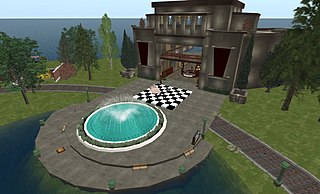
A virtual museum is a digital entity that draws on the characteristics of a museum, in order to complement, enhance, or augment the museum experience through personalization, interactivity, and richness of content. Virtual museums can perform as the digital footprint of a physical museum, or can act independently, while maintaining the authoritative status as bestowed by the International Council of Museums (ICOM) in its definition of a museum. In tandem with the ICOM mission of a physical museum, the virtual museum is also committed to public access; to both the knowledge systems embedded in the collections and the systematic, and coherent organization of their display, as well as to their long-term preservation.
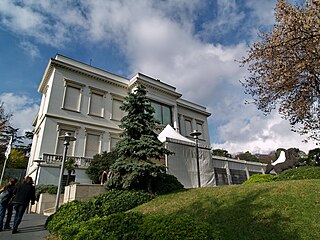
The Sabancı University Sakıp Sabancı Museum is a private fine arts museum in Istanbul, Turkey, dedicated to calligraphic art, religious and state documents, as well as paintings of the Ottoman era. The museum was founded by Sakıp Sabancı, and was opened in June 2002. Aside from permanent exhibitions, the museum also hosts national and foreign temporary exhibitions and, hosts cultural events on the weekends.
Lin Hsin Hsin is an IT inventor, artist, poet and composer from Singapore, deeply rooted in mathematics and information technology.

Museo Galileo is located in Florence, Italy, in Piazza dei Giudici, along the River Arno and close to the Uffizi Gallery. The museum, dedicated to astronomer and scientist Galileo Galilei, is housed in Palazzo Castellani, an 11th-century building which was then known as the Castello d'Altafronte.
Rhizome is an American not-for-profit arts organization that supports and provides a platform for new media art.

The sociology of the Internet involves the application of sociological theory and method to the Internet as a source of information and communication. The overlapping field of digital sociology focuses on understanding the use of digital media as part of everyday life, and how these various technologies contribute to patterns of human behavior, social relationships, and concepts of the self. Sociologists are concerned with the social implications of the technology; new social networks, virtual communities and ways of interaction that have arisen, as well as issues related to cyber crime.
DeviantArt is an American online art community that features artwork, videography and photography, launched on August 7, 2000 by Angelo Sotira, Scott Jarkoff, and Matthew Stephens among others.
Prasad Studios & Prasad Film Labs are motion picture post-production studios headquartered in Chennai, India, founded by Prasad Group in 1956. The production house has produced over 150 movies in Telugu, Tamil, Kannada, Malayalam and Hindi.
Barry Lam is a Taiwanese billionaire businessman, and the founder and chairman of Quanta Computer. He is also a patron of the arts and a philanthropist in the area of culture and education.

The visual arts are art forms such as painting, drawing, printmaking, sculpture, ceramics, photography, video, filmmaking, design, crafts, and architecture. Many artistic disciplines, such as performing arts, conceptual art, and textile arts, also involve aspects of the visual arts as well as arts of other types. Also included within the visual arts are the applied arts, such as industrial design, graphic design, fashion design, interior design, and decorative art.
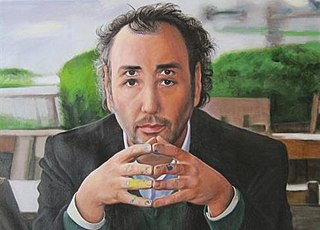
Genco Gülan (Turkish pronunciation: [dʒendʒo ˈɟylan] is a contemporary conceptual artist and theorist, who lives and works in Istanbul. His transmedia contextual work involves painting, found objects, new media, drawings, sculpture, photography, performance and video. His work often carries political, social and/or cultural messages. He describes his work as idea art.
Auriea Harvey and Michaël Samyn are two artists who collaborate on creating art video games. Auriea Harvey is a Professor for Games at the Kunsthochschule Kassel.

Ars Electronica Linz GmbH is an Austrian cultural, educational and scientific institute active in the field of new media art, founded in Linz in 1979. It is based at the Ars Electronica Center (AEC), which houses the Museum of the Future, in the city of Linz. Ars Electronica's activities focus on the interlinkages between art, technology and society. It runs an annual festival, and manages a multidisciplinary media arts R&D facility known as the Futurelab. It also confers the Prix Ars Electronica awards.

Franz Fischnaller is a new media artist and transdisciplinary researcher. He is recognized for the creation of his digital, virtual reality and interactive art installations works across the fields of art, technology, humanities and cultural heritage.

Chiara Passa is a visual artist working in media art since the second half of the 1990s.
References
- ↑ Lin Hsin Hsin Archived 2007-06-12 at the Wayback Machine , Singapore Infopedia, National Library Board, Singapore.
- ↑ Lin Hsin Hsin Archived 2011-05-27 at the Wayback Machine , Speaker Biographies, Museums and the Web: An International Conference, Los Angeles, California, March 16–19, 1997.